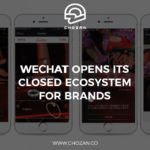The long-awaited Double Eleven Shopping Festival has just ended. This year’s event has received a lukewarm reception from Chinese shoppers. In fact, for the first time in the festival’s history, Alibaba and JD did not release full sales numbers. However, Alibaba has stated on Saturday that the festival outcome is in line with last year’s gross merchandise volume (GMV) performance.
This is not a total shock as companies such as Alibaba have been trying to take attention away from GMV for a while now. The Singles’ Day Shopping Festival, also known as Double Eleven, is not just a seasonal sales occasion. Analysing the sales and consumer behaviour during Double Eleven help merchants and brands better understand Chinese consumers in order to fine-tune their China strategy, and spot notable trends for their businesses.
Alibaba, JD, Suning, Douyin and many others are also paying special attention to tech, client retention (CRM functions), new product launches, trend watching and more during Double 11. The festival is no longer purely about sales, GMV and returns.
The total GMV from all major e-commerce platforms has crossed RMB 1 trillion for the first time, according to Syntun. According to their analysis, traditional e-commerce platforms netted over RMB 934 billion, while newer streaming to e-commerce platforms like Douyin netted around RMB 181 billion.

Source: Statista
However, although there has been positive growth seen in this year’s Double Eleven, it is difficult to ignore China’s declining economy. With Chinese consumers getting thriftier and more reluctant to spend lavishly, this has been a major concern for some brands. In fact, overconsumption is frowned upon now among consumers and the people of China. This is not only due to the slowing down economy, but also because of China’s “Common Prosperity” policy that was recently re-cemented as a high priority on its economic agenda.
Digital Marketing Spend on Double Eleven in China
In China, a minimum of 30-50% of brand earnings are usually reinvested in marketing. The balance between marketplace and non-marketplace marketing is around 50/50 for many brands.
Platforms such as Tmall, JD, and others are examples of marketplaces. Typically, 50-70% of this spending is utilised to improve major sales occasions such as Double Eleven, 618, CNY, and superbrand days, with the remaining 30% used for routine traffic maintenance, which is commonly performed through search.
The outside market budget is often allocated as follows: 40% is spent on advertising and platform alliances, 30% on influencers and KOLs, 20% on live streaming, and 10% on content creation.
Naturally, each brand is distinct, and there are no one-size-fits-all formulae here. Brands with little awareness are almost likely going to invest much more in branding and content, whereas well-known brands can run more sales-as-a-target advertising.

Source: ChoZan
This year the distribution is changing. As mentioned, while GMV is still very important, brands are looking for new ways to evaluate their Double Eleven success in 2022 and beyond. The festival is no longer a single sales and discounts extravaganza, but a festival of creativity, loyalty, gamification, new product launches, sales and new marketing formats.
Brands are investing significant portions of their yearly marketing budget into Double Eleven success, so here are a few directions beyond GMV you shall take your 11.11 promotions.
Metrics to Measure Double Eleven Success
It is important to note that there is absolutely no single indicator when it comes to measuring the success of your campaign. So while GMV is the obvious one, there are other methods that can decide whether or not your Double Eleven has been successful or not.
1. Leveraging Double Eleven to acquire new members and strengthen consumer loyalty
Double Eleven could be used as a tool to help brands recruit new members. This could be a crucial step that brands need to take in order to improve customer loyalty over the long term. Over one billion people in China are now considered annual active consumers across all of Alibaba Group’s consumer-facing companies.
This is a significant new benchmark. Taobao and Tmall have a retention rate as high as 98% of high-quality customers spending more than RMB 10,000 each year, and it has more than 25 million members of its 88VIP loyalty program, who spend more than RMB 57,000 each year on average with Alibaba.
Brands and retailers might use Tmall Double Eleven to better understand consumers, recruit new members, and amass consumer insights as a kind of long-term asset by leveraging the platform’s features. The number of band members on Tmall has climbed by more than thirty percent on average during the course of the previous year (2021). More than forty different brands each have more than ten million subscribers under their own umbrella. This year’s Tmall Double 11, the contribution of brands’ members will become a vital indicator of the long-term development of the brand.
Brands consistently amass Tmall members as long-term assets, which will enable them to increase the operational efficiency of their sales, marketing, and new product development operations. Tmall is a Chinese e-commerce platform. Both Taobao and Tmall assist companies in growing their customer bases, which ultimately leads to greater success.
Think about things like these:
1. The rate of transaction conversion among members is significantly greater than among typical customers
2. Members typically have a high level of loyalty and a high percentage of retention
3. In order to incubate new products, marketers could use the improved understanding of members as a resource.
2. Launch new products and further win the consumer mindshare
Double Eleven is the ideal time for brands to introduce new products to the market; retailers and manufacturers could take use of Double Eleven to increase public awareness of their newest offerings. The introduction of new products has become the primary motivator for companies’ brands and platforms.
This year will be no exception. Ferrari released a new clothing line, while new brands entered the China market in time for the festival, including Else, a plant-based infant formula and baby cereal company; Nanushka, a Budapest-based design house; and Filippa K, a Swedish fashion brand.

Source: Zhihu.com
Tmall Innovation Center (TMIC), the dedicated new product incubation platform that is part of Alibaba, is in a strong position to assist companies in the development and launch of new goods. Considering the size of the market and the rate at which consumer preferences and requirements shift, the creation of new products can be an endeavour that is high in both risk and expense. TMIC provides brands with consumer insights and tactical solutions, allowing them to speed their product development and assure a better degree of success. This enables TMIC to assist in overcoming these problems.
They accomplish this through the following methods: trend detection, in which they use their insights to form a bird’s-eye view of consumers’ preferences on everything, ranging from ingredients and flavours to product packaging; consumer co-creation, in which they leverage the Taobao app to enable brands to directly engage with consumers, collect real-time feedback, and adapt products accordingly; and lastly, product optimization. testing tools, which allow brands to test new products, branding, or prices in a simulated shopping environment; our ecosystem of strategic partners, which includes raw material suppliers, designers, universities, and research houses; the goal is to provide brands with everything they require in order to launch innovative new products.
The previous year, TMIC collaborated with Nivea China, one of the brands owned by Beiersdorf, to develop two new creative products. These included a male skincare product that contains tiger grass and is intended for consumers who stay up late, as well as a cleanser for women with sensitive skin. Both companies made extensive use of the insights provided by TMIC throughout the entirety of the NPD cycle, including in their simulated testing platform. Because of this, Nivea was able to easily validate ideas, alternatives, product claims, and designs in as little as two weeks, which greatly accelerated the speed at which the product could be brought to market.
3. Build up multiple digital formats to serve and engage with consumers
Brands might use high-quality digital commerce infrastructure and new marketing technologies to improve the consumer experience and win consumer mindshare.
During the ongoing Singles’ Day Grand Promotion, JD emmployed technologies such as VR, AI, and digital collectibles in omni-channel scenarios, assisting in the creation of an emotional connection and fulfilling consumers’ need for an exclusive buying experience.
Louis Vuitton’s modern LV Archlight Sneaker, a traditional CELINE Ava purse, and BULGARI Divas’ Dream necklace were all experienced in 3D visualisation, allowing JD shoppers to view product details from a 360-degree range of vision. CELINE thoughtfully incorporated a size comparison option, using an iPhone as a reference, so that shoppers can visually assess the actual size of the Ava bag; similarly, BULGARI Divas’ Dream necklace continues to offer augmented reality (AR) try-ons for several colours of the jewellery.
Source: JD
Some luxury businesses choose blockchain-based digital collectibles to highlight their distinct products. From November 6 to 11, customers who bought one of 20 specific products at JD’s Max Mara flagship shop were eligible for a limited-edition digital collectible depicting a skiing teddy bear. For the first 500 customers, German firm MCM has also produced a digital collectible of its M PUP VISETOS doll. Digital collectibles inherit brand features and unveil modern novelty while embodying the companies’ timeless legacy and increases the brands’ charm.
According to a report by the Boston Consulting Group (BCG) and Tencent Marketing Insight (TMI), the relevance of the digital ecosystem in terms of luxury goods purchasing channels continues to grow. According to Yaok Institute, a luxury research and consultancy firm, online sales of luxury items will account for more than 30% of the industry’s total transaction volume in China.
In this context, JD’s fashion and lifestyle business, J Shop, offered more novel digital techniques to assist its over 400 premium brands in embracing the metaverse based on technological capabilities, digitally intelligent supply chain, mature operating mechanism, and so on. By seamlessly bridging the physical-digital divide, luxury brands and customers will achieve a balance in an immersive experience both online and offline throughout the purchasing journey, contributing to the expansion of online luxury consumption.
4. Spot the trend and be well positioned in the long term
By utilising Double Eleven, companies and merchants were able to gain an understanding of China’s most recent consumption trend and better position themselves to capitalise on emerging opportunities. We have seen niche products, such as unisexual underwears, clean-beauty skincare, glamping and outdoor sports-related products, and sustainable consumption, become best-sellers within the previous few years’ Double Eleven.

Source: JD
JD saw a significant increase in keyword searches for terms such as “energy-saving,” “green,” “low-carbon,” “organic,” and others. JD began the “Green Impact Initiative” in May, labelling roughly a million products on its platform with ecologically friendly labels.
JD Home Appliances’ popular trade-in services saw a seven-fold increase in orders year on year. This also means that during the Double Eleven this year, 2 out of every 10 home appliance orders on the JD platform received this service. Many people exchanged their old washing machines or refrigerators for newer models or even cross-category options, especially smart phones or watches.
Conclusion
By taking part in Double Eleven, brands have the opportunity to make further adjustments to their sales and product plans, test out cutting-edge marketing tools, and increase the ability of their supply chains to execute.
More crucially, with Double Eleven, the brands will be able to ensure business certainty in the midst of macroeconomic instability and create a firm foundation for the step-by-step development of their long-term strategies.
While creating and maintaining a marketing strategy for the Double Eleven Shopping Festival is integral, it is just as important to not neglect to calculate its success. This is done to not only know what the brand has done right and wrong but to also better adjust their strategy for either the next Double Eleven or just any other significant shopping festival.
If you’re looking to better prepare for your Chinese shopping festival strategy, Alarice is here to help. We prepare a campaign strategy to use in-house or execute it for you.
Get in touch now to stand out from the crowd.





